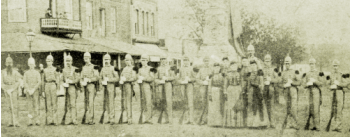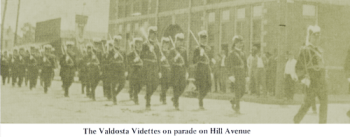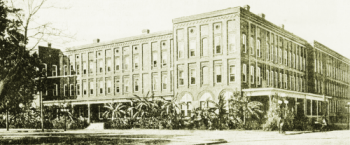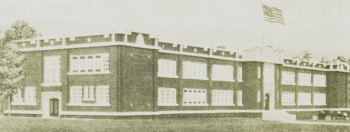Lowndes County Timeline
1540
Hernando de Soto and Spanish soliders came through the area, finding friendly Indians who gave them corn.
1700
Spanish priests and soldiers from missions in North Florida and South Georgia converted Indians.
1800
Creek and Seminole Indians hunted throughout Lowndes County.
1814
General Andrew Jackson subdued the Indians of South Georgia and North Florida and exacted territory from them in the Treaty of Fort Jackson. Irwin County, the precursor of Lowndes County, was one of several counties created from this session.
1820
Lots of 490 acres in Irwin County went to lucky winners in the Land Lottery. If a man's name was drawn with a lot number he paid a fee of $18 to the state and gained the lot.
1823
Sion Hall arrived in the area, built a house and later a store on the Coffee Road.
1825
Lowndes County was created December 23 from the southern part of Irwin County.
1826
Following an election, county clerks, a tax collector, sherriff, coroner and surveyor were sworn in as the first officials of the new County of Lowndes.
1828
 Franklinville, the first county seat, was laid out near the Withlacoochee River in the northeast section of the county.
Franklinville, the first county seat, was laid out near the Withlacoochee River in the northeast section of the county.
The Judge of Lowndes Superior Court heard cases of perjury, simple larcency and malicious mischief.
1830
Samuel E. Swilley had built a substantial log house on his farm in the Mud Swamp area and housed his four male and ten female slaves in log cabins in the midst of his corn field.
1836
The Militia under Col. Henery Blair, Captains Enoch Hall, Levi J. Knight and Hamilton W. Sharpe engaged a group of Creek warriors in the Battle of Bushy Creek.
1837
Troupville became the county seat of Lowndes. By 1860, the tree-lined village at the confluence of the Little and Withlacoochee Rivers thrived with a court house, a famous hotel "Tranquil Hall", several stores and shops, and a newspaper, The South Georgia Watchman.
1840
 The first Baptist congregation was organized in Troupville by seven charter members, two of whom were black slaves.
The first Baptist congregation was organized in Troupville by seven charter members, two of whom were black slaves.
1843
Moses Smith bought fractions of three land lots in the 16th district.
1845
James Newton returned to the state of Georgia $1,873 of property taxes from Lowndes County.
1850
Levi J. Knight resigned his commission as Major General of the 6th Division of the Gerogia Militia, an office he held since 1840.Clinch County was formed from parts of Lownes and Ware County.
1854
St. John the Baptist Masonic Lodge organized at Troupville.
1856
Berrien and Colquitt Counties were created from parts of Lowndes.
1858
Brooks County was created form Lowndes and Thomas Counties and Echols from Lowndes and Clinch.
1860
 The city of Valdosta was incorporated by the Legislature on December 7.
The city of Valdosta was incorporated by the Legislature on December 7.
The engine known as Satilla Number Three pulled the first Atlantic and Gulf train into Valdosta.
1861
I.H. Tillman and C.H.M. Howell, Lowndes County delegates to Georgia's secession convention, voted with the majority for withdrawl from the union.
1862
Levi J. Knight resigned a commission as major in the Confederate Army. His son, Levi J. Knight Jr., succeeded to his command.
1863
 Several families, refugees from the fighting in North Georgia, came to Valdosta on the railroad and settled in the new town.
Several families, refugees from the fighting in North Georgia, came to Valdosta on the railroad and settled in the new town.
Lt. Reuben T. Roberds, who had been the first mayor of Valdosta, died at Knoxville, TN, as an officer of the "Valdosta Guards".
1864
Refugees from Liberty County, hit hard by Sherman's march to the sea, organized what came to be known as the First Presbyterian Chruch in Valdosta.
1865
The first regularly assigned, full-time Methodist minister arrived in Valdosta. He was the Rev. George Smith, a wounded and partially paralyzed Civil War veteran who sat while preaching.James H. Pierpoint taught music in Valdosta. He was later to compose "Jingle Bells".
Federal troops of Company "G", 103rd U.S. Colored Troups, were stationed in Valdosta.
1866
Samuel McWhir Varnedoe founded the county's first real school, the Valdosta Institute.
1867
The South Georgia Times, predecessor to the Valdosta Daily Times, started publication.
1868
Alvin B. Clark, the last agent of the Freedman's Bureau for Lowndes, Brooks and Berrien Counties resigned and became tax collector.
1869
Dr. W. H. Hooker, a Kentucky missionary, became minister to a Valdosta congregation that associated with The Disciples of Christ.
A destructive fire on the western side of Patterson Street and a second fire in 1870 led to the establishment of two fire companies. Volunteers of the Paterson Fire Company (White) and the Osceola Hook and Ladder Company (Black) wore red flannel shirts, black trousers and black hats; members of the Osceola Company also wore red aprons.
Fire in the office of the Ordinary, W. H. Dasher, destroyed records of the County.
1875
 A brick Court House was built on the Court House Block and was used unitl a new one was built in 1904-05.
A brick Court House was built on the Court House Block and was used unitl a new one was built in 1904-05.
1875
The Lowndes Volunteers, a home guard militia group, was organized with uniforms modeled after West Point.
1878
C.C. Varnedoe and Company was founded.
1880
The census reported the Naylor community had a population of 1,688 and the Valdosta community a population of 1,515.
1881
Lowndes County paid $350 for 35 acres 2.5 miles from town to be used as a poor farm.
1885
A group of Episcopalians bought a lot and errected a chapel on East Central Avenue.The town purchased the private Valdosta Institute, thereby establishing a public school system.
1889
The Georgia Southern and Florida Railroad arrived in Valdosta from the north expanding trade and business greatly.
1890
Farmers in Lowndes County produced 6,280 bales of ginned cotton.
The Valdosta Videttes, a voluntary military company commanded by James O. Varnedoe, drilled on the public square between Ashley and Lee Streets.
1895
The Valdosta City Council authorized the erection of poles, wiring and other equipment by the Southern Bell Telephone and Telegraph Company and the Valdosta Telegraph Company.
1896
Ringling Brothers Circus appeared in Valdosta for the first time.
1898
The Valdosta Street Railway Company secured the right to operate street cars on Toombs, Patterson, Ashley, Lee, Troup, Hill, Central, Crane and Gordon Streets.About one thousand people gathered at the railroad station in APril to greet regular troops en route to Tampan, which was to be a staging area for the Spanish American War.
1899
A fire in Lake Park destroyed 14 buildings in the business section.The Valdosta Primitive Baptist Church was organized and ocupied the building formally used by the First Baptist Chruch.
The state fair between October 31 and November 1 attracted visitors from considerable distances to see the area's arts and industries, prize winning livestock and long staple Sea Island cotton which Lowndes County was the world's inland capital.
On the night of July 1, local citizens sponsored a "Bohemian Smoker" for oficials of the Atlantic, Valdosta and Western railroad. the third line to arrive in the county.
B.F. Strickland incorporated a cotton mill in August, opening with 5,000 spindles and 125 looms.
1900
The Wymodausis Club, the first women's club in Valdosta, organized and elected Mrs. Mattie R. Stevens president.
1901
Valdosta Chapter 471, United Daughters of the Confederacy, was orgainzed.The Carpenter's Union ran a notice to the public that members thereafter could be expected to work only 9 hours a day.
1902
The City Council passed the first sanitary ordinance upon completion of the new sewer line.
Valdes Hotel opened at the corner of Toombs and Hill Avenue.
1903
The Withlacoochee River rose one foot above the trestle for over three quarters of a mile of the Georgia Southern and Florida track. The railroad put coal cars on the bridge to keep it from washing away.Street paving began on Hill Avenue, using "vitrified bricks" and granite curbing.
1904-5
The Court House was constructed.
1905
Valdosta High School on Central Avenue was built.The first paid fire department was established with one chief and 4 firemen.
1907
 Lowndes County went dry because local ministers and church women conducted a campaign that overwhelmingly convinced voters to try Prohibition.
Lowndes County went dry because local ministers and church women conducted a campaign that overwhelmingly convinced voters to try Prohibition.
1908
Rabbi Levine was called to Valdosta to minister to the Jewish community, which consisted of about 16 families in 1913.J. N. Bray Lumber Company was established
The General James Jackson Chapter of the Daughters of the American Revolution was orgainized.
1910
The Valdosta City Council set speed limits. No one was permitted to drive faster than eight miles an hour within the fire limits or faster than twelve miles an hour in the city beyond the fire limits.
The Post Office and Federal Building opened at the corner of Lee Street and Central Avenue.
1911
The Confederate Memorial constructed by the UDC was dedicated.The Lowndes County Board of Health was created.
1912
The Valdosta-Lowndes County Chamber of Commerse was established J. T. Blalock was the first president.
1914
Col. W. S. West appointed U.S. SenatorThe Carnegie Library of Valdosta was opened to the public, Margret Jamison was librarian.
South Georgia Pecan Company was established.
George Baker, a young black evangelist calling himself "The Messenger of God", was arrested on a lunacy warrent by Valdosta Police. After his release, he journied slowly northward and eventually emerged as Father Divine.
1915
As part of the tick eradication program, the County Commissioners contracted 25 dipping vats built at $75 each. They were 27 feet long, 6.5 feet deep and held 1,500 gallons of solution.
Little-Griffin Hospital was erected on North Patterson Street.
The boll weevil fist appeared in Lowndes County cotton fields. The crop of 1917 was devastated.
1916
Georgia and Florida Railroad hired a tobacco expert to assist farmers in handling flue-cured tobacco.The Valdosta Counry Club was organized.
1917
Lowndes County supplied timber, naval stores, cotton and food stuffs to the war effort. Nearly 1,300 men and women from Lowndes County served in the armed forces.
1918
Lanier County was formed from Lowndes, Berrien and Clinch Counties.
1919
Twenty-one charter members established the Rotary Club of Valdosta.
1922

The Valdosta High School was built on Williams Street early in the administration of School Superintendent A. G. Cleveland.
1923
The first tobacco market in Lowndes County opened in Hahira.
1924
The Salvation Army began operations in Valdosta.
1927
The Citizens and Southern Bank, the parent of which was The Merchant Bank of Valdosta, became Citizens and Southern National Bank.
1932
American Legion Home built.
1933
Lowndes County became involved in the Civil Works Administration, a federally created work relief program that employed men and women hard hit by the depression.
1934
The first electric traffic signals were installed in Valdosta.
1936
The W.P.A. operated sewing rooms in Valdosta, Hahira and Lake Park, giving jobs to unemployed women and produing thousands of garments to be distributed to persons in need of clothing.Harley Langdale and others formed the American Turpentine Farmers Association.
1940
Radio station WGOV went on the air.The City Council purchased 500 acres of land on the Madison Highway for an airport.
1941
Eleanor Roosevelt dedicated the new library at The Georgia State Woman's College.
1942
Moody Field opened as a pilot training base during WWII.
1945
The Livestock Auditorium was built by the county.
1946
National Airlines inaugurated commercial air service to Valdosta.
1950
Georgia State went coed and became Valdosta State College.
1953
In October, the first carload of pulpwood was delivered to National Container Corp., which later became Owens-Illinois.
1955
Pineview General Hospital, now South Georgia Medical, opened.
1962
Ground was broken for Valdosta Area Vocational - Technical School.
1964
Seven thousand citizens turned out to greet Mrs. Lyndon B. Johnson when the Lady Bird Special stopped in the area.
1967
Five Points Shopping Center opened at the convergence of North Patterson, Ashley and Oak Streets.
1969
The Post Office and other Federal offices moved to new quarters on Patterson Street.Valdosta High School and Pinevale High School were consolodated
1971
Coach Wright Bazemore retired after leading the Valdosta Wildcats to nearly 300 victories and 14 state championships.
1975
Valdosta Municipal Airport opened expanded facilities, and Southern Airways instituted jet service.• • • • • • • • • • •
Source: "Pictoral History of Lowndes County 1825-1975"